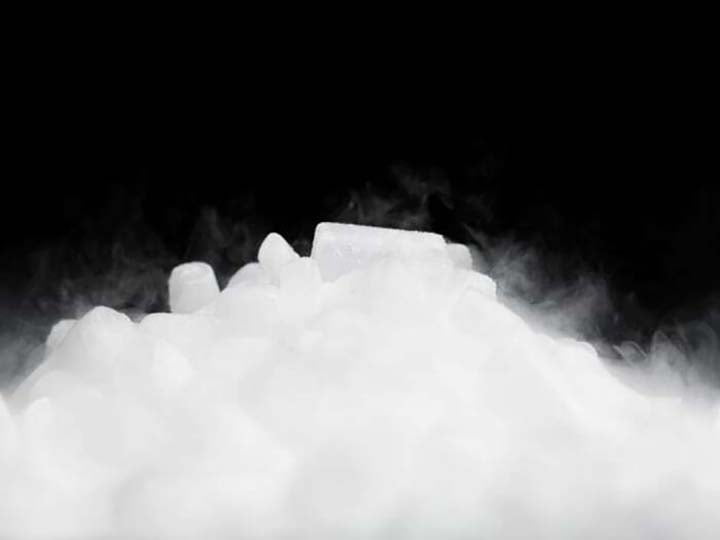Dry ice is a solid form of carbon dioxide (CO2) that is often used in a variety of applications, including food preservation, medical and scientific experimentation, and special effects in entertainment. Unlike regular ice, dry ice does not melt but instead sublimates (changes directly from a solid to a gas) at a temperature of -109.3°F (-78.5°C). This makes it an ideal choice for applications where a rapid transition from a solid to a gas is desired, as well as for applications where traditional ice would not be feasible due to the amount of space required for storage.
What is dry ice
Dry ice is a solid form of carbon dioxide (CO2) used for cooling and preservation. Unlike regular ice, dry ice does not melt, it sublimates directly into a gas. Dry ice is colder than regular ice and is used for a variety of cooling applications. However, it is extremely cold and can cause frostbite if touched with bare skin, so it must be handled with caution.

How to make dry ice at home
If you’re interested in making dry ice at home, here’s a step-by-step guide to help you get started:
Step 1: Obtain a supply of carbon dioxide (CO2) gas
The first step in making dry ice is to obtain a supply of carbon dioxide gas. CO2 gas can be purchased from suppliers that specialize in the production and sale of dry ice. Be sure to choose a reputable supplier that can provide you with a high-quality, pure form of CO2 gas.
Step 2: Compress the carbon dioxide gas
Once you have obtained a supply of CO2 gas, the next step is to compress it using a machine known as a compressor. This will increase the pressure of the gas, causing it to condense into a solid form. The exact specifications of the compressor will vary depending on the amount of CO2 gas you want to compress, but in general, you will want a compressor that can achieve a pressure of at least 800 psi.
Step 3: Cool the compressed carbon dioxide gas
The next step is to cool the compressed carbon dioxide gas to a temperature of -109.3°F (-78.5°C). This can be done using a specialized cooling system that is designed to achieve the desired temperature. The exact specifications of the cooling system will depend on the amount of CO2 gas you want to cool and the conditions under which you will be working.
Step 4: Store the dry ice
Once the compressed CO2 gas has been cooled to the desired temperature, it will change from a gas to a solid, forming dry ice. The dry ice should be stored in a properly ventilated area, as it will sublimate (evaporate) into CO2 gas at a rate of approximately five to ten pounds per day.
Safety Considerations
It is important to handle dry ice with caution, as it is extremely cold and can cause frostbite if it comes into direct contact with skin. To avoid injury, always wear protective gloves or use tongs when handling dry ice. Additionally, dry ice can be hazardous if it is stored in an enclosed space, as the sublimation process will release CO2 gas into the air. To avoid the risk of suffocation, be sure to store dry ice in a well-ventilated area.
Is it OK if you touch dry ice?
No, it is not safe to touch dry ice with bare skin. Dry ice is extremely cold and can cause frostbite, which is a type of injury to the skin and underlying tissues. Touching dry ice can cause pain and redness, as well as more serious injury, such as blisters, numbness, and in severe cases, tissue damage. To avoid injury, always wear protective gloves or use tongs when handling dry ice. If you do come into contact with dry ice, it is important to wash the affected area with warm water to help prevent frostbite.

How long will dry ice last?
The length of time that dry ice will last depends on several factors, including the temperature and humidity of the environment it is stored in, the size and thickness of the pieces, and the type of container it is stored in. In general, dry ice will last anywhere from 24 to 48 hours in a well-insulated container. However, the amount of time dry ice will last can be longer or shorter depending on the specific conditions.
To maximize the lifespan of dry ice, it should be stored in a well-insulated container, such as a Styrofoam cooler, and kept in a cool, dry place away from direct sunlight and other heat sources. Additionally, the lid of the container should be tightly sealed to slow down the sublimation process and prevent the release of CO2 gas.
In conclusion, the lifespan of dry ice varies, but it is generally between 24 and 48 hours. Proper storage in a well-insulated container and a cool, dry environment can help to extend its lifespan.
Conclusion
Making dry ice at home can be a fun and educational project, but it is important to follow the steps outlined above and to take the necessary safety precautions to ensure that the process is carried out safely and successfully. Whether you’re using dry ice for food preservation, scientific experimentation, or special effects, you’ll find that this versatile material offers a wide range of potential applications and can provide you with many opportunities for creative expression and exploration.
Shuliy Machinery is a leading dry ice machine manufacturer in China. We have quite rich experience in the research, design, manufacturing, and supply of various dry ice machines, such as dry ice making machine, dry ice blasting machine, dry ice briquette machine, dry ice block machine, etc. If you want to start your industrial dry ice making business, contact us for more details.

